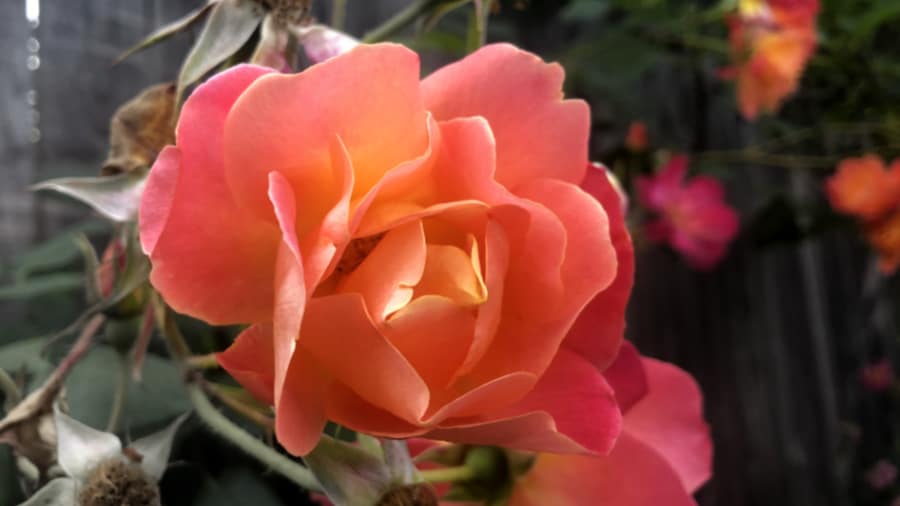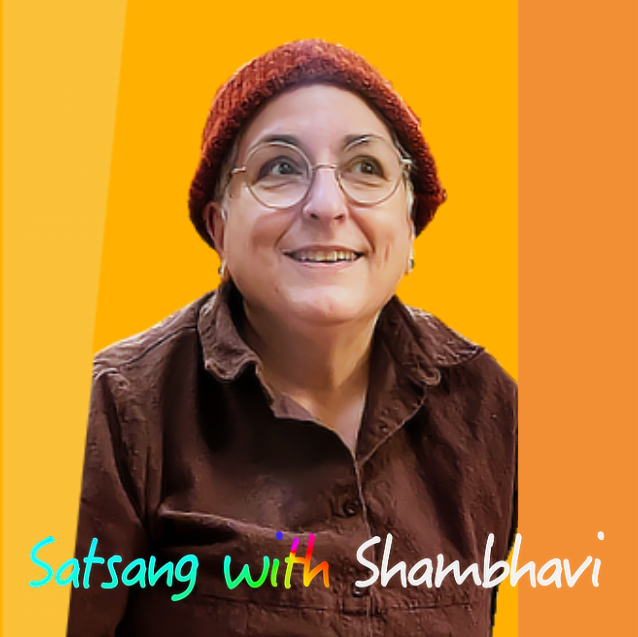Shambhavi talks about letting go of the witness and becoming immersed in living presence. A podcast from Satsang with Shambhavi
SHAMBHAVI
The question is about that he knows logically how to do open-eyed meditation. He knows logically how to do open-eyed meditation, but he finds himself witnessing, like being more of a witness, which he knows is the exact opposite of what you've been instructed to do.
So he wanted me to talk about that. This is something that I've noticed over the years that students very much have trouble with. And this is because we don't pay very much attention to our senses as we're moving through the day, other than our sense of vision and our minds in an intellectual sense.
So we very much overuse our minds and our vision to the detriment of our other senses, like touch and smell and hearing and just the sensation of being alive in the world. There's really three things that trip us up when we're trying to do meditation in this kind of tradition.
One is over-reliance on mind and vision. The other is— we have developed this very, very strong samskara of self-observation. So we are always— most people are always thinking about, in some way or another, how other people are seeing them. How am I appearing to others? How are other people judging me, or how am I being received?
And so there's this vigilance that we have trained ourselves in that is very much like the witness. And I find that many people are looking at themselves as if they were an outside person, to see how other people might be seeing them. And we get into this habit, it becomes so ingrained that we barely even notice that it's happening.
And then the third obstacle that we have is our usually just in passing contact with— or perhaps being brought up in a different kind of tradition from India or Tibet, let's say, where there is some kind of emphasis on playing the role of the witness.
So there's a lot of teachings that say when we're meditating, we're being detached. We're playing the role of the witness, we're not getting involved, we're being desireless. We're not having any emotions—we don't even want to have any sensations!
So in a sense, there are some traditions, mostly Advaita Vedantic traditions, particularly from India, where this sort of eyes-on-a-stick attitude is very much cultivated. In other words, you're a person—you're just like a stick with some eyes on top of it. What you're looking at is the rest of the world.
This idea of detachment gets interpreted in a very crude way to mean that you're not feeling anything and not desiring anything. And this is not what detachment really means.
It's a big topic, and it's worth talking about over and over again. Because even when people have good instruction in open-eyed meditation from this kind of tradition, for instance, sahaja meditation from India, or all the various kinds of traditions that are similar from other countries, trekchö and shikantaza and Mahamudra are all just different names of open-eyed meditation that are taught in other traditions from other countries.
No matter how much good instruction people have, we have this very deep samskara of playing the role of the witness to the degree that even when someone has an intellectual understanding that they're being told to stop doing that, they can't stop doing it.
It has gained so much momentum that this idea that we're observing things and commenting on them, including on ourselves, is really hard to stop doing.
This is why we have three levels of meditation. The first level of meditation is listening abiding. And what are we doing in listening abiding? We're opening the gates of our perception. We're using the capacity for hearing to open up our sense of— sensitivity to our environment.
And this is helping us to enter into meditation in a more direct realization way. What we are doing in general is we're opening the gates of our perceptions. We're releasing our perceptions from their limitations. And this means that we are not blocking anything out or taking up any position with respect to anything. There is no position to be held with respect to anything that's happening.
And there's a word for this, which is samavesha. Samavesha means immersion. We are becoming sensitized to our immersion in living presence. We are immersed in living presence the way that an air molecule is immersed in the air or water is immersed in the ocean. We are already immersed in living presence because we're full of it and we're made of it and we're made by it.
So we are not creating anything. Meditation, as is often said in the direct realization traditions, meditation is without a speck of meditating. Meditation is what we do to enter into what has been called, particularly in Dzogchen, natural contemplation, or what is called in the direct realization traditions of India, simply naturalness—spontaneous, effortless, naturalness.
So when we enter into that, when we're entering into this state of effortless being, we are just using meditation technique to kind of dive off the diving board and enter into the water. But once we're in the water, there's no technique, there's no meditation. There's no sense of meditating.
There's just being natural, being relaxed with the gates of the senses open and meeting whatever is there. So there's no sense of being an observer in a formal way in which you would take up a position. When we're leaving meditation and entering into naturalness or natural contemplation, there's no view, there's no technique. There's no taking up of any position whatsoever.
At the same time, there is awareness, but that awareness is not localized. So there's also another misperception that if you are immersed in living presence, if you are entering into naturalness using whatever meditation technique you have— so in Jaya Kula, we go from one kind of meditation that has somewhat more technique, listening abiding, to shamatha, which has a little less technique, to sahaja, which has even less technique, but still some technique.
But ultimately we are dropping all of that and just relaxing and being in a natural state, and then we're just continuing in that. That's it.
So there's a misconception. And this is a misconception that is had by so many teachers, not just students, that you can't think when you're in that condition, that no thoughts will happen. And I love the teachings from the direct realization traditions about this, which fundamentally say, if a thought can interrupt your enlightenment, what good is your enlightenment? [laughs]
Even if your own samskaras that you experience, even if they can interrupt whatever enlightenment you have, what good is it? So there's this idea going around which is completely erroneous, I think, and my best teachers have taught this, and this is certainly my own experience, that even to be in a human form, even to be appearing as a human being, is a samskara.
Maybe there's been some rare human being who could at will change their form—I don't know who that would have been. But 99. 99% of us, including those who are considered highly realized, are going to be condemned to stay in one form for their entire tenure here. That is a samskara. So as Swami Lakshmanjoo said, we can be like Lord Shiva, we can't be Lord Shiva.
So this idea of total enlightenment is bullshit, basically, he says, and I agree. He didn't say it that way, but he said we can be like Lord Shiva. But what that means is that whatever enlightenment, or self-realization, is vouchsafed to a person in the human realm—to a human being—is going to also include some samskaras that we have.
So the relaxation and the immersion is going to host all of that. So we're not worrying about being thought-free. We're not even worried about being karma-free.
As we go along and we practice, more karmas will relax. The way of being in the world will become more effortless, will become more spontaneous, will become more equanimitous, will become more loving, more compassionate. All those things will just happen naturally.
More of an experience of natural devotion will develop. We'll have more of an understanding of reality and how things are and how things work.
And one of the things that always surprised me, and still does actually surprise me, is how we start to understand ritual in a very direct and spontaneous way. That the meanings of the gestures of the rituals that we do become transparent in their intent and their effect. And that's always just been magic to me and continues to develop over time as I continue to practice.
So all those things happen and we're able to feel that immersion more continuously. But we're still going to be to some degree bound by samskaras, bound by karma. And the idea is that we are just hosting that within that state of relaxation, so we become less bothered by ourselves. That's wonderful also.
But this taking the position of the witness is reinforcing dualistic experience that we already are doing mostly 24/7. So we're just trying to relax and remember to be in your senses. Remember to be feeling.
One of the experiences that started coming to me after many, many decades of practice is feeling directly what Abhinavagupta taught, that our senses are deities playing in the field of duality— or what Ma said, we are the arms and legs of God. We're the sensory apparatus of God.
And as that self-referentiality begins to go away, the experience of being immersed in the senses without a center—I don't know if this makes any sense to anybody—but being immersed in the senses without a center, without a locus for the person or the I, starts to also develop.
And that sense of just playing in the textures and the flows of intelligence and communication also happens. There is awareness, and we are still thinking. There were experiences I've had for moments where some very traditional things happened, things that you read about in books, like you stop breathing and the sense of self is very very different.
But, you know, I'm kind of a brat. So even in those moments, I would— I wonder if I can think something! [laughs] And basically there's just awareness there, it can do whatever it wants. If it wants to think something, it can.
But it's more about the senses, the perceptions, including the mind, but not about thinking about things or having any distance as a witness. So you're not thinking, oh look, I'm experiencing that. It's just, this is happening, this is being experienced.
You know, I love words, and I love to write, and I love to communicate. And so when I was your age and younger, I just had narration going on in my mind all the time. And it wasn't annoying to me at all. It was pleasurable, it was me recreating the world in words, and I loved it.
So at some point, after I'd been practicing for a while, I realized that it was an obstacle, that it was creating a distance between me and the world. But I just thought, I'll never be able to stop this, ever. I'm too addicted to it. And one day it just was gone.
I just kept practicing, and one day it was just gone. It'll be taken away. Keep practicing. Then if you try to go back to it, just too darn effortful. Not worth it.
STUDENT 1
I had a question about destruction. I'm having trouble relating to it. I was wondering if you could give some context.
SHAMBHAVI
You said you understand purification, but you're not quite as understanding of destruction? From the perspective of this kind of tradition, the entire practice is destructive. Our view is that enlightenment is our essence nature. Everything is already full of wisdom. So there's nothing to create.
There's no compassion to cultivate or consciousness to expand or any of the things that people say. Consciousness already pervades all of existence. It's completely awake, completely enlightened. And those wisdom virtues like compassion and mercy and kindness and creativity are actually what everything is already made of. So there's nothing to strive for in that sense.
And what we are doing is we're collaborating with this alive aware reality to destroy impediments to our recognition of what we already are.
So we already are that and we just have forgotten it temporarily because of temporary obscurations to our perceptions, including our mind. And the analogy that's used is like clouds going over the sun, that even if there's clouds over the sun, the sun is still shining in full measure. We just can't see it.
If we came to the conclusion that we had to create a new sun or cultivate sun—that is sort of the position that other people and other traditions are in from our perspective, is saying I'm going to expand sun or make sun or cultivate sun—from our perspective we're just going to remove clouds, and so we can experience the full light of the sun again.
So in a sense this practice is entirely destructive, and this is why in this kind of tradition, the fierce forms of God are more prominent—like Bhairava, the fierce form of Shiva, or Kali, the fierce form of Ma Shakti. Fierce forms are more predominant because the pride of place is given to destruction.
And the reason I say you don't have to relate to it is because it isn't really the right tradition for everybody. If the sound of that makes your heart go pitta patter and sounds thrilling, then maybe it is. But if it just sounds scary or unreal or you don't buy it or you don't want it, then that's really completely fine also.
There's plenty of traditions that don't have this attitude. So don't feel that you have to be okay with it, really all I'm saying. We wouldn't say you need any improvement.
We even have to stop being attached to improving and fixing ourselves, which is, of course, our great occupation these days. And if we're not busy approving and fixing ourselves, what the heck are we supposed to be doing with our time, right?
Sign up to receive email updates
Enter your name and email address below and I'll send you periodic updates about the podcast.


